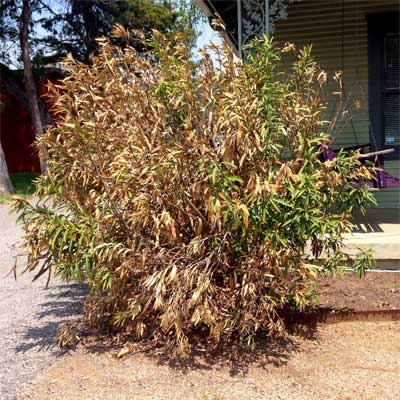Assessing the Freeze Damage

It’s hard to determine if plants are going to come back after a really hard freeze. It takes time to evaluate the extent of the damage. However, we’ve waited long enough. I can probably help you with some of them. Here are a few that I’ve seen across big parts of Texas. (No particular order.)
• Asian jasmine has been browned badly over half or more of the state. However, unless you’re in or near the Panhandle, it should come back for you. You’ll need to trim off the dead stubble, and when you do, you’ll probably see new shoots starting to sprout.
• Confederate star jasmine, although a sister to Asian jasmine, isn’t nearly as winter-hardy. If its stems and leaves are browned, it probably has bid you goodbye.
• Texas sage is native to Southwest Texas. At least in the DFW area, I’m seeing a ton of thinning and dieback. So, while it may be drought-tolerant, it does have a weakness, that being its inability to take really cold North Texas weather. If you have Texas sage plants that are trying to send out new foliage, trim the plants back by one-third to one-half to foster strong, new shoots. Apply an all-nitrogen fertilizer to speed things along, then water them deeply.
• Primrose jasmine is a large, arching shrub noted for its golfball-sized, rose-like, soft yellow flowers. There is a large planting in a freeway median in McKinney, and those several hundred plants don’t look like they’re going to make it. I lost my three plants, and I don’t see them offering to send out new sprouts.

• Crape myrtles are, for the most part, doing just fine. However, just as we saw six or seven years ago following a hard freeze in early December, several varieties seem to have frozen back to the ground in North Texas. I’m watching Tuscarora, Muskogee, Natchez and Country Red. They seem to be the prime candidates. The good news is, they were all started from cuttings, so when they send up new sprouts, you’ll have the same variety. Trim out the dead stalks and retrain the new shoots. You’ll be surprised at how rapidly your plants will look as good as new.
• Oleanders also have frozen back to the ground across big swaths of Texas. Like crape myrtles, they are sending up new sprouts from below. Trim off the dead tops and let the new shoots begin. They may not bloom for a couple of years, but the plants will be lovely.
• Rosemary finally got caught by the cold. We’ve used it almost as a shrub in recent years, and the time was going to come. It came. As you replant, choose upright types. They seem to be more winter-hardy, especially Madeline Hill hardy rosemary.
• Gardenias, if they turned brown, are lost. This is a good time to replant them, because it gives you the longest possible time to get them established before next winter’s cold.
• Loquat in North Texas? Really? Don’t be surprised if you live in the northern half of the state and you have a loquat that died. They are sub-tropical trees. If yours turned brown, it won’t come back, and you need to find another type of tree to replace it.
• Palms were really hurt, or at least some of them were. By now you should be seeing new growth emerge. Wait another couple of weeks. If you see none, the plant probably won’t be coming back.
• Pittosporums are South Texas shrubs, particularly variegated and dwarf types. If their leaves are browned and their stems wrinkled, those plants have been lost. It’s time to replace them with a hardier species. Let your nurseryman guide you.

